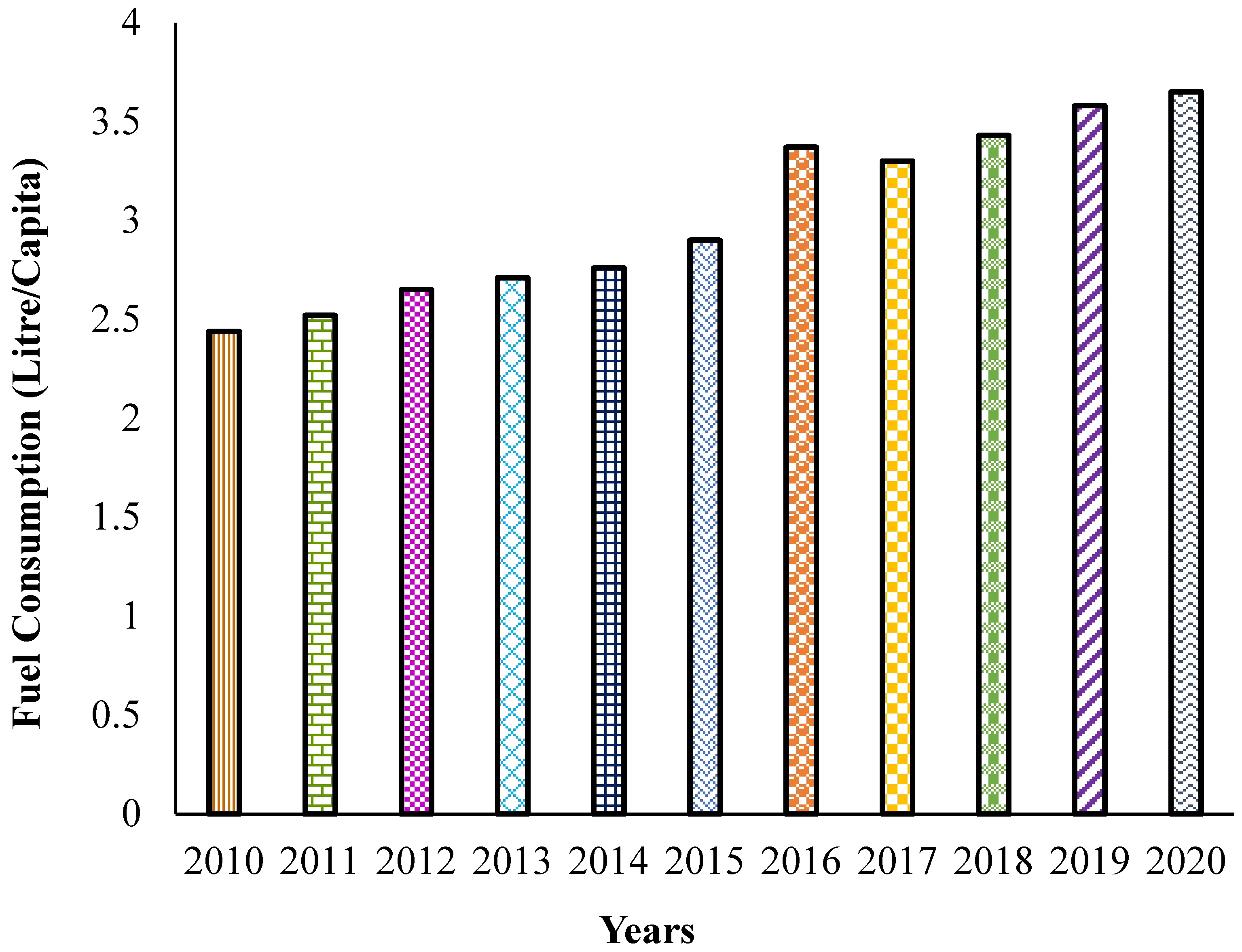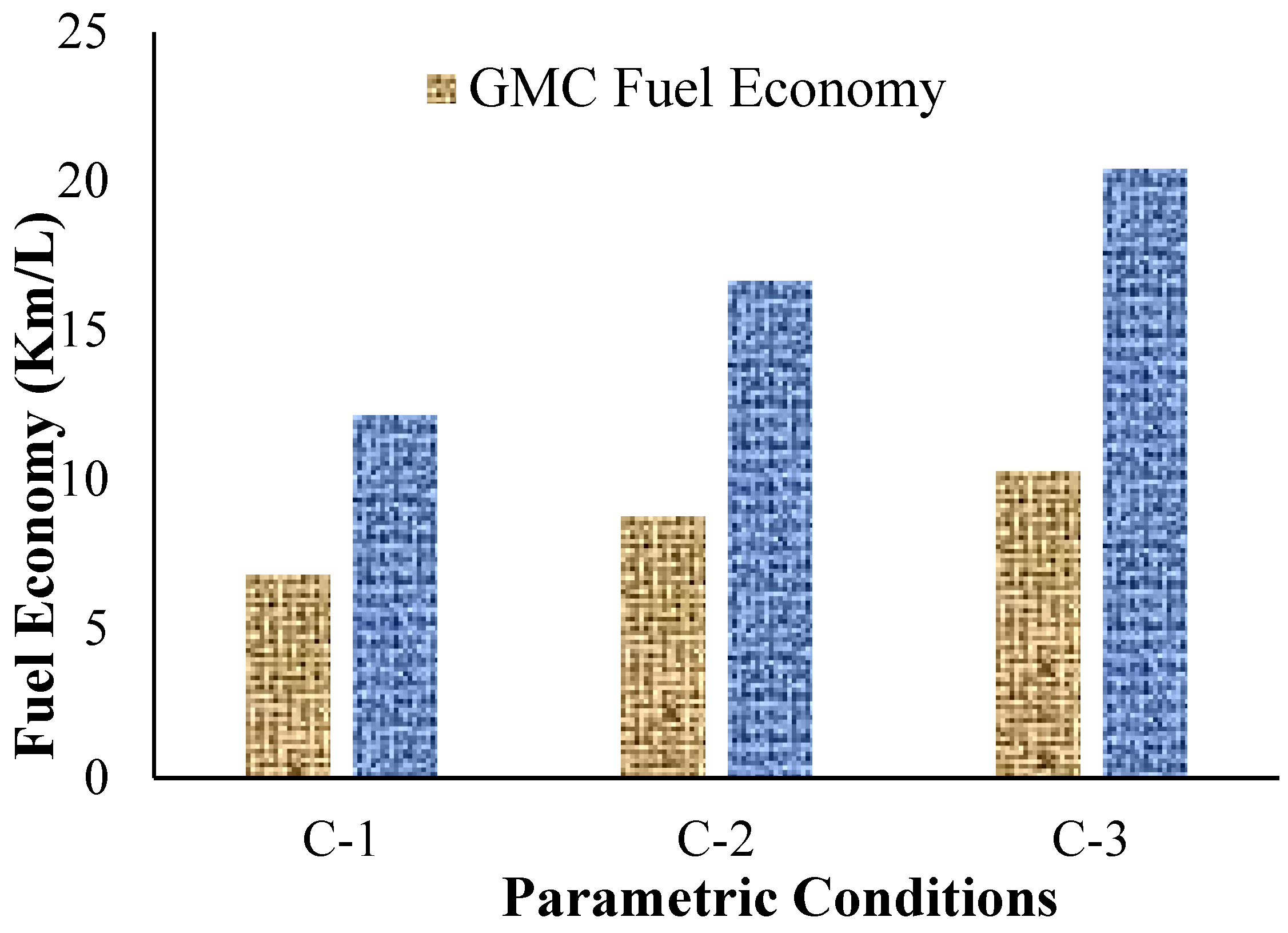With the recent advancements in the automobile industry, researchers have been considering prominent statistical methods to evaluate fuel consumption for enhancing economic efficiency. Interestingly, the in-depth literature on fuel consumption has provided a roadmap to the scientific community for analyzing the efficiency of the fuel under the dynamic variations in the inherent parameters of the vehicle [
1,
2,
3]. Additionally, different attributes of the scientific studies have been considered to uplift the transportation-sustainable development systems. Researchers have comprehended that vehicle fuel consumption is highly correlated by the traffic patterns, speed of the car, weather conditions, road-graded characteristics, and inherent properties or models of the deliberated vehicle [
4,
5]. Prominently, the demand for nonrenewable energy is also expected to increase by 36.5% in the next 5-year period from 2019–2024; however, this growing demand is particularly associated with the petroleum products of the automobile industry [
6,
7]. Therefore, researchers have been considering fuel economy to develop an interaction between renewable and nonrenewable energy sources for environmental sustainability [
8,
9]. Besides, the estimated integration between renewable and nonrenewable energy for petroleum products has shifted major attributes of global policy toward the contentment of fuel economy [
10]. Furthermore, the conventional utilization of nonrenewable energy sources also depicts the emissions of uncertain gases that indirectly have major health concerns as well as environmental issues (Climate Change). Importantly, researchers have also notified that in this 21st century it is quite difficult to completely incorporate renewable energy sources into the automotive industry [
11,
12].
Consequently, the scientific community has been considering different statistical models for the assessment and prediction of the nonrenewable petroleum trends in the betterment of sustainable transportation systems [
13]. In this regard, fuel economy enlightens the automobile efficiency of consumption in petroleum products and is expected to have a substantial impact in reducing adverse environmental effects [
14,
15]. Additionally, at the individual and firm level, the focus on fuel economy is also likely to create substantial benefits in terms of the expected reduction in vehicle operating costs [
16,
17]. A critical aspect in the attainment of fuel economy has been considered to evaluate the performance of the factors that influence automobile fuel consumption. Interestingly, there are several empirical research studies in which researchers have surveyed the correlated data of environmental and technical factors for the economic efficient vehicle transportation [
18,
19,
20]. Researchers have established a systematic review design for the performance evaluation of automobiles in the United States (US). Researchers have highlighted that the type of fuel, car design, weight of the vehicle, and engine performance have a significant impact in determining the fuel consumption of automobiles [
21,
22]. On the other hand, experimental data from three Vauxhall Cavalier cars (1300 cc, 1600 cc (petrol), and 1600 cc (diesel)) have been collected and analyzed by incorporating the statistical technique of factorial analysis. Based on the established analysis, researchers have enlightened that the trends in fuel consumption primarily varied with the urban and suburban motorway environments [
23]. Apart from that, different inherent parameters such as traffic patterns, tire pressure, car speed, and the rate of gear change have also been noted to have a significant effect on fuel consumption for all three Vauxhall Cavalier automobiles [
24,
25,
26]. The traffic patterns in Saudi Arabia have been comprehensively analyzed by considering a case study in which researchers have evaluated the environmental factors. They highlighted the limitations and inherent factors that may adversely affect sustainable transportation systems. Furthermore, based on the outcomes, they have recommended the utilization of their designed study for investigating the performance of different vehicles under various environmental conditions [
27]. Another aspect of the transportation system is noticed in which researchers have conducted a survey to analyze the usage of bicycles, and based on the outcomes, they have concluded that only 1.7% of bicycles have been specifically utilized for sustainable drives [
28]. Additionally, researchers have also highlighted that in the suburban environment, the car throttle velocity could be a dominant variable to adversely affect the trends in fuel consumption [
27,
28]. Likewise, the primary survey design with 250 car drivers has been investigated in three major capital cities of Pakistan for the generation and collection of the empirical data. Interestingly, results revealed that car mileage, the extent of automobile maintenance (engine oil replacement), and the number of prior car drivers are inherently important factors that determine the rate of fuel consumption [
29,
30]. Similarly, researchers have numerically investigated the advanced driving assistance systems (ADAS) with over 100 drivers, and results have been compared with the available outcomes of the afore-explained methodology [
31,
32]. Essentially, they found that the amplitude of vehicle acceleration and automobile speed would potentially affect the consumed liters of fuel. Furthermore, a comprehensive assessment of the fuel consumption is also studied in which researchers have investigated the levels of fuel consumption in terms of various environmental factors. The external factors such as altitudes, air pressure, and wind speed have an acceptable impact on the desired fuel economy. However, it is also highlighted that the statistical models usually consider such external variables as random factors because of their inaccessibility and dynamic abruptness [
33,
34]. In this regard, several research studies have also been studied to manipulate these coherent variables in the optimization of consumed fuel trends for better visualization and evaluation of sustainable economic automobiles [
35,
36,
37]. Additionally, researchers have also found a strong correlation between tire pressure and fuel consumption. Results have also indicated that fuel consumption can be decreased up to approximately 5.2% with the increase in tire pressure by 1 pound per square inch (PSI). In the recent past, the technical aspects of engine oil have been considered to analyze vehicle performance, and it is noted that 5–20 W engine formula (type of oil) would be best suited for increasing fuel efficiency [
38,
39].
The findings of the above-described vehicle transportation methodologies have been limited by certain empirical laws, and a major gap has been seen in the multidomain validated statistical optimization for vehicle fuel economy. Limited research has also been observed in the individual contributions of the correlated input factors toward the attainment of the desired fuel economy. The proposed work highlights the significance of the integrated statistical approach by implementing the factorial design of the experiment, analysis of variance, and multivariate regression model on the realistic data of the vehicle fuel economy. The outcomes of the factorial design of the experiment have highlighted that fuel economy is optimal under the low air conditioner temperature, light traffic patterns, and 34 PSI tire pressure. Analysis of variance has been utilized to justify the statistical outcomes and highlight the statistically correlated input factors of the model. A multivariate regression model is also incorporated to investigate the individual influence of correlated input factors on the response variable (fuel economy). A normality test has been included to validate the statistical outcomes, and it is concluded that the correlated factors have more influence on the fuel economy of the GMC Yukon as compared to that of the Toyota car model. Based on the results obtained, it is highly recommended to utilize the proposed methodology in analyzing the correlation between the factors affecting the vehicle fuel economy.














